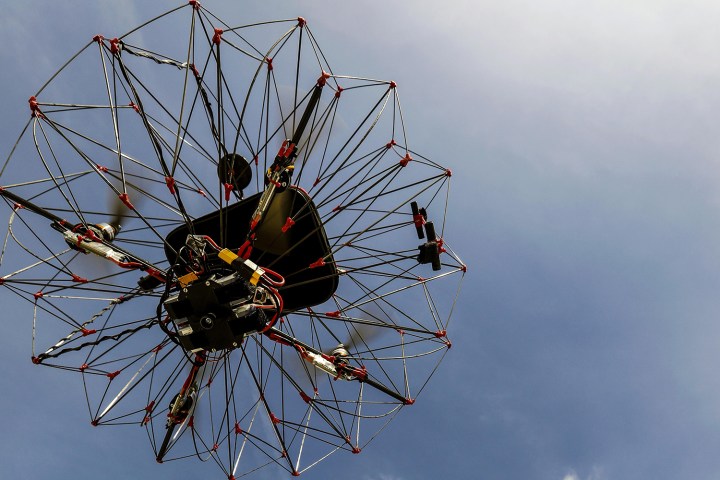
When unfurled, the drone can fly above buildings and traffic, while carrying a package up to 500 grams (a bit over one pound). When folded up, the drone is small enough to fit into a backpack.
Developed in EPFL’s Laboratory of Intelligent Systems, the delivery drone was designed to combine two functions. On one hand, the drone transports cargo; on the other hand, it serves as a protective packaging, acting like a resilient cage to keep cargo safe during its transit.
It’s also meant to be packable, so the drone’s designers turned to the ancient art of origami. Relying on principles of origami folding, the cage can be packed and unpacked in one motion. When not in use, it can be flattened in a few seconds, decreasing its volume by 92 percent.
The outer cage is made of flexible, yet durable carbon fiber to protect cargo from collisions. Within the carbon-fiber cage is a four-propeller multicopter, which allows the drone to perform vertical take offs and landings. With about a pound of cargo, the drone can travel about two kilometers (one and one quarter miles).
The drone’s propellers are positioned inside the cage so that they don’t pose a risk to their surroundings, including customers, who can grab the package midair without risk of injury. The researchers also included a safety feature that turns the propellers off once the cage is opened. They’re planning on adding a parachute to slow its descent if it breaks down mid-flight.
“Drone deliveries require to ensure safety for people,” Przemyslaw Kornatowski, the EPFL researcher who developed the drone, told Digital Trends. “That is why we integrated a quadcopter inside a cage. The cage physically separates fast rotating propellers from environment, thus provides safety for people and for the drone while flying close to obstacles.”
Cool as the concept may be, don’t expect to receive a package from this drone anytime soon. Kornatowski said the drone is ready for person to person deliveries but will need to integrate path-planning algorithms and obstacle avoidance features to accommodate deliveries on a larger scale.
Meanwhile, companies like Amazon are gunning to overcome hurdles to make drone delivery commonplace and only in December made its “first real” delivery. Elsewhere they’ve been used to transport samples between hospitals and and during deliveries.
The EPFL team have only recently underwent tests with people with more tests to come.


